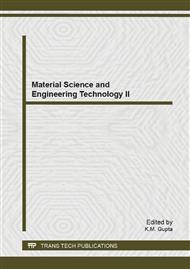[1]
T. Itoh, Numericals technics for microwave passive structures, Wiley, (1989).
Google Scholar
[2]
R.E. Collin, Field theory of guided waves McGraw-Hill, (1960).
Google Scholar
[3]
H. Baudrand, Introduction au calcul de circuits microondes, Ed. ENSEEIHT (1992).
Google Scholar
[4]
M. Koshiba, M. Sato, Application of the finite-element method to H-plane waveguide discontinuities, Electron. Let., vol. 18, pp.364-365, (1982).
DOI: 10.1049/el:19820249
Google Scholar
[5]
R. Chada, K. C. Gupta, Segmentation method using impedance matrices for the analysis of planar Microwave, IEEE Trans. Microwave Theory Tech., vol. MTT-29, pp.71-34, Jan. (1981).
DOI: 10.1109/tmtt.1981.1130292
Google Scholar
[6]
E. Hammerstad, O. Jensen, Accurate models for microstrip computer-aided design, IEEE MTT-S International symposium digest, Washington , pp.407-409, (1980).
DOI: 10.1109/mwsym.1980.1124303
Google Scholar
[7]
M. Koshiba, M. Suzuki, Application of boundary-element method to waveguide discontinuities, IEEE Trans. Microwave Theory Tech, vol. -MTT 34, pp.301-307, (1986).
DOI: 10.1109/tmtt.1986.1133330
Google Scholar
[8]
W. Menzel, I. Wolf, A method for calculating the frequency dependent properties of microstrip Discontinuities, IEEE Trans. Microwave Theory Tech., Vol. MTT-25, pp.107-112, (1977).
DOI: 10.1109/tmtt.1977.1129049
Google Scholar
[9]
R. Mehran, Calculation of microstrip bends and Y-junctions with arbitrary angle, IEEE Trans, Microwave Theory Tech., vol. MTT-26, pp.400-405, (1978).
DOI: 10.1109/tmtt.1978.1129401
Google Scholar
[10]
M. Kirschning and al, Measurement and computer aided modeling of microstrip discontinuities by a improved resonator method, MTT-S Int. Microwave Symp. Dig., pp.495-497, (1983).
DOI: 10.1109/mwsym.1983.1130959
Google Scholar
[11]
G. Kompa, S-Matrix computation of microstrip discontinuities with a planar waveguide model, Arch. Elec. Ubertrugung., vol. 30, pp.58-64, (1976).
Google Scholar
[12]
A. Mittal, K. K. Gupta, G.P. Srivasta, P.K. Singhal, R. D. Gupta, and P.C. Sharma, Contour integral analysis of planar components, J. Microwaves and Optoelectronics, Vol. 3, N°3, 58-72, (2006).
Google Scholar
[13]
D. Lilonga-Boyenga, C. N. Mabika, G. Okoumoumoko, Rigorous analysis of uniaxial discontinuities microwave components using a new multimodal variational formulations, Progress In Electromagnetic Research, Vol. 2, pp.61-71, (2008).
DOI: 10.2528/pierb07102403
Google Scholar


